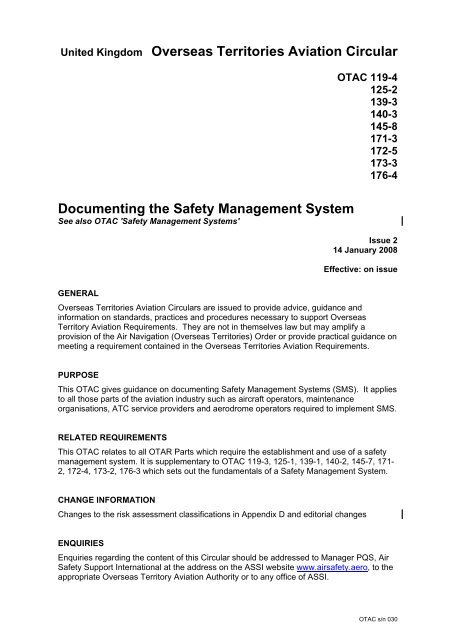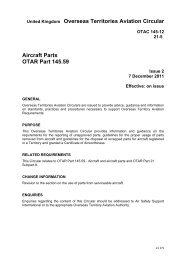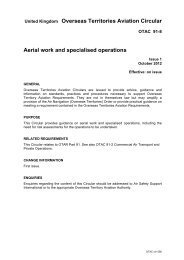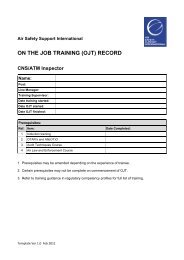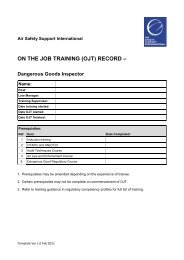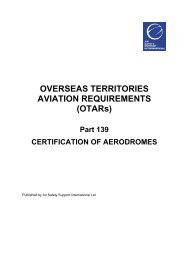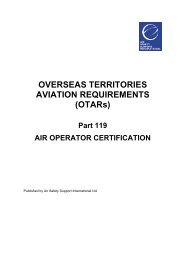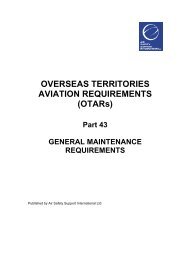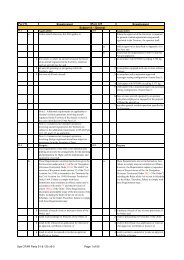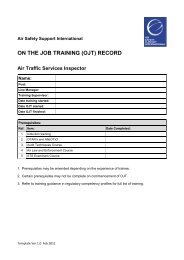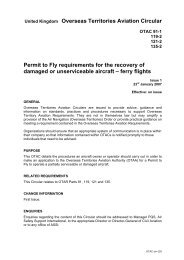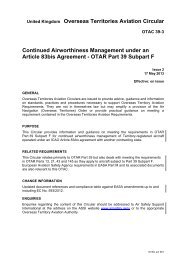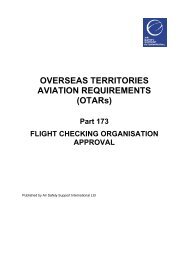UK Overseas Territories Aviation Circular (OTAC) - Air Safety ...
UK Overseas Territories Aviation Circular (OTAC) - Air Safety ...
UK Overseas Territories Aviation Circular (OTAC) - Air Safety ...
Create successful ePaper yourself
Turn your PDF publications into a flip-book with our unique Google optimized e-Paper software.
United Kingdom <strong>Overseas</strong> <strong>Territories</strong> <strong>Aviation</strong> <strong>Circular</strong><strong>OTAC</strong> 119-4125-2139-3140-3145-8171-3172-5173-3176-4Documenting the <strong>Safety</strong> Management SystemSee also <strong>OTAC</strong> '<strong>Safety</strong> Management Systems'Issue 214 January 2008Effective: on issueGENERAL<strong>Overseas</strong> <strong>Territories</strong> <strong>Aviation</strong> <strong>Circular</strong>s are issued to provide advice, guidance andinformation on standards, practices and procedures necessary to support <strong>Overseas</strong>Territory <strong>Aviation</strong> Requirements. They are not in themselves law but may amplify aprovision of the <strong>Air</strong> Navigation (<strong>Overseas</strong> <strong>Territories</strong>) Order or provide practical guidance onmeeting a requirement contained in the <strong>Overseas</strong> <strong>Territories</strong> <strong>Aviation</strong> Requirements.PURPOSEThis <strong>OTAC</strong> gives guidance on documenting <strong>Safety</strong> Management Systems (SMS). It appliesto all those parts of the aviation industry such as aircraft operators, maintenanceorganisations, ATC service providers and aerodrome operators required to implement SMS.RELATED REQUIREMENTSThis <strong>OTAC</strong> relates to all OTAR Parts which require the establishment and use of a safetymanagement system. It is supplementary to <strong>OTAC</strong> 119-3, 125-1, 139-1, 140-2, 145-7, 171-2, 172-4, 173-2, 176-3 which sets out the fundamentals of a <strong>Safety</strong> Management System.CHANGE INFORMATIONChanges to the risk assessment classifications in Appendix D and editorial changesENQUIRIESEnquiries regarding the content of this <strong>Circular</strong> should be addressed to Manager PQS, <strong>Air</strong><strong>Safety</strong> Support International at the address on the ASSI website www.airsafety.aero, to theappropriate <strong>Overseas</strong> Territory <strong>Aviation</strong> Authority or to any office of ASSI.<strong>OTAC</strong> s/n 030
Documenting the SMS <strong>OTAC</strong> 119-4, 125-2, 139-3, 140-3, 145-8, 171-3, 172-5, 173-3, 176-4CONTENTS1 DEFINITIONS......................................................................................................... 32 CONTEXT ............................................................................................................. 33 GENERAL ............................................................................................................. 34 DOCUMENTING THE POLICY ................................................................................... 45 OBJECTIVES FOR IMPROVEMENT ........................................................................... 46 ROLES AND RESPONSIBILITIES............................................................................... 47 DOCUMENTING THE SMS PROCESSES................................................................... 57.1 Implementation plan......................................................................................... 57.2 Identification of hazards ................................................................................... 57.3 Risk assessment and mitigation....................................................................... 67.4 Monitoring and evaluation ................................................................................ 78 DOCUMENTING THE REGULATIONS......................................................................... 89 TRAINING PROVISIONS .......................................................................................... 810 EMERGENCY RESPONSE PLAN............................................................................... 811 FURTHER ADVICE AND GUIDANCE .......................................................................... 9APPENDIX A OBJECTIVES AND SAFETY PERFORMANCE MEASUREMENT ...................... 10APPENDIX B EXAMPLES OF ISSUES THAT SHOULD BE REPORTED ............................... 11APPENDIX C HAZARD/UNSAFE CONDITION/ERROR/INCIDENT REPORT FORM ............... 12APPENDIX D RISK ASSESSMENT MATRIX ................................................................... 13<strong>OTAC</strong> s/n 030 Issue 2 Page 2 of 13
Documenting the SMS <strong>OTAC</strong> 119-4, 125-2, 139-3, 140-3, 145-8, 171-3, 172-5, 173-3, 176-41 DefinitionsThe following definitions are reproduced from OTAR Part 1 for ease ofreference:Quality assurance means all those planned and systematic actions necessaryto provide adequate confidence that a system, component, or facility willperform satisfactorily in service.<strong>Safety</strong> management system (SMS) means a systematic approach tomanaging safety, including the necessary organizational structures,accountabilities, policies and procedures.2 Context2.1 <strong>OTAC</strong> 119-3, 125-1, 139-1, 140-2, 145-7, 171-2, 172-4, 173-2, 176-3 describesin general terms the requirements for <strong>Safety</strong> Management Systems (SMS) inthe <strong>Territories</strong>, and gives suggestions for implementation. It applies to all thoseparts of the aviation industry such as aircraft operators, maintenanceorganisations, ATC service providers and aerodrome operators required toimplement SMS.2.2 Any SMS must be properly documented to ensure traceability, standardisationand communication, and if necessary to enable co-ordination with externalservice providers and contactors.2.3 It must be emphasised that the SMS needs to be designed to meet the specificneeds of the individual organisation. It follows that the methods chosen fordocumenting SMS will not all be exactly the same. The suggestions andexamples given in this <strong>OTAC</strong> are intended to illustrate some of the possibilities,however it will be up to each organisation to ensure that their documentationreflects their own needs.2.4 The aim of any organisation in documenting their SMS should be to ‘write whatyou do and do what you write’, and no more. Only those tasks or actions andassociated documentation which are required to make the SMS effective shouldbe added.3 General3.1 The policies and procedures relating to the SMS will typically be expressed as acomponent of existing manuals (e.g. the Aerodrome Manual, Unit Manual of <strong>Air</strong>Traffic Services, Operations Manual, Maintenance Control Manual etc.) but maybe contained in a separate SMS manual if the company prefers. In any case,detailed local procedures in other documents can be cross-referenced, so theSMS manual is likely to be thin.3.2 The documentation must include a description of each component of the systemand should clearly describe the interrelationships between each of thesecomponents. This is essential if company personnel, and the regulator, are tounderstand how the whole system is integrated. (Including a diagram of theSMS structure can assist.)<strong>OTAC</strong> s/n 030 Issue 2 Page 3 of 13
Documenting the SMS <strong>OTAC</strong> 119-4, 125-2, 139-3, 140-3, 145-8, 171-3, 172-5, 173-3, 176-43.3 In common with all other aspects of the SMS, in order to ensure that the systemis used and maintained effectively it is essential that the documentation reflectsquality assurance principles; and complies with the requirements of theoperator’s quality system, if applicable.4 Documenting the policy4.1 There needs to be a clear statement of the organisation's policy, managementprinciples and intentions, for a continuous process of improvement in the safetylevel - signed by the Chief Executive and/or Accountable Manager of theorganisation.4.2 This can take many forms, but simpler is better. Here are some examples:• Our objective is the proactive management of identifiable risks and theelimination of injury to personnel and damage to equipment. To that end, wewill continuously examine our operation for hazards and find ways to minimizethem. We will report incidents, train staff on safety management, document ourfindings and our responses, and strive for continuous improvement.• To prevent accidents and to eliminate damage or injury, this company willmaintain an active safety management system. I support the open sharing ofinformation on all safety issues and encourage all employees to reportsignificant safety hazards or concerns. I pledge that no disciplinary action willbe taken against any employee for reporting a safety hazard or concern to thiscompany’s management. I pledge also that no staff member will be asked tocompromise our safety standards to get the job done.5 Objectives for improvement5.1 A key element in implementing SMS will be for the organisation to identify itsobjectives for safety improvement. To be meaningful these will have to includean element of safety performance measurement. It is important that theobjectives are achievable, and they should be reviewed on a regular basis.5.2 For the purpose of defining these objectives accident rates are not an effectivemeasurement of safety, for in reality there will always be latent unsafeconditions within the system that might, if left unattended, lead to an accident.For example, an assessment of the improvements made to work/operatingprocedures might be far more effective than considering accident rates. Seekinginput and involving all employees at this stage should make the task easier.5.3 Once the safety objectives have been identified, they should be documented sothat they can be communicated. A statement could be made to accompany thetop level policy statement above.5.4 To illustrate safety objectives and possible safety performance measures someexamples are given in Appendix A.6 Roles and responsibilities6.1 For the SMS to function effectively the roles and responsibilities of all personnelmust be defined. Everyone needs to be aware of their responsibilities - and itshould be clearly stated that everyone has a responsibility for safety.<strong>OTAC</strong> s/n 030 Issue 2 Page 4 of 13
Documenting the SMS <strong>OTAC</strong> 119-4, 125-2, 139-3, 140-3, 145-8, 171-3, 172-5, 173-3, 176-46.2 The responsibility for implementing and managing the components of an SMSwill normally be given to the nominated postholders for specific parts of a largerorganisation, for example the Operations Manager, Maintenance Manager etc.That person will in turn be held accountable to show that he or she has made areasonable effort to implement SMS.6.3 Here is an example to start with:Ultimate responsibility for safety in the company rests with myself as theaccountable executive. Responsibility for making our operations safer foreveryone lies with each one of us - from managers to front-line employees.Each manager is responsible for implementing the safety management systemin his or her area of responsibility, and will be held accountable to ensure that allreasonable steps are taken to prevent incidents and accidents.6.4 Depending on the size and complexity of the organisation there will also be aneed to give descriptions of the roles and responsibilities of, for example, eachof the nominated postholders. If possible a '<strong>Safety</strong> Adviser' should benominated, who does not have responsibility for managing safety but to provideadvice direct to the Accountable Manager.6.5 Clearly it is important that all these descriptions reflect the reality of the rolesundertaken.7 Documenting the SMS processes7.1 Implementation plan7.1.1 Implementing SMS is a challenge for operators and regulators alike. At theinitial stages it will help to record the results of the "Gap Analysis" used toidentify which components have to be developed. Identifying who will do whatand setting timescales provides a useful framework and a basis for liaison withthe <strong>Overseas</strong> Territory <strong>Aviation</strong> Authority.7.1.2 Communicating the plan at all levels to everyone involved in the operation isessential to the implementation and continued effective functioning of the SMS,and for developing an active safety culture. Commitment and flexibility arerequired from the start.7.1.3 Guidance on implementation planning is included in paragraph 6 of <strong>OTAC</strong>119-3, 125-1, 139-1, 140-2, 145-7, 171-2, 172-4, 173-2, 176-3 <strong>Safety</strong> ManagementSystems.7.2 Identification of hazardsNote: A 'hazard' is any condition or circumstance that could result in damage orinjury.7.2.1 Proactive approaches to identification of hazards involve actively seeking forthem before they cause a problem. A procedure for reporting safety concerns,for example hazard/unsafe condition reports, is an example of being proactive.This boils down to encouraging reports of events that MIGHT occur as well asevents that did occur. Gathering data on both is equally important. In practice,an organisation may find it convenient to develop a single report form suitablefor all these reports.<strong>OTAC</strong> s/n 030 Issue 2 Page 5 of 13
Documenting the SMS <strong>OTAC</strong> 119-4, 125-2, 139-3, 140-3, 145-8, 171-3, 172-5, 173-3, 176-47.2.2 Risk assessments can also be proactive. These should be carried out inrelation to all hazards identified initially, and then programmed to take place atregular intervals and whenever changes are planned - for example introductionof new equipment or changes in key personnel.7.2.3 Depending on the complexity of the changes, consideration should be given todeveloping a Project <strong>Safety</strong> Management Plan to ensure that the SMS functionsare coordinated and applied effectively throughout the transition.7.2.4 The proactive and reactive approaches can become complementary whencollating the hazard/unsafe condition reports, together with error reports andinformation from accident and incident reports. Other sources of informationcould include line management judgement, workplace opinions and auditreports. Some expertise will usually have to be applied to the informationreceived to ensure that the hazards are properly identified and, depending onthe source, verified before attempting risk analysis.7.2.5 The secret to long term success is to use a simple report form and encouragereporting by making it easy. For example -• have a collection box• keep supplies of report forms where they are handy• print your non-punitive disciplinary policy on the form• allow anonymous reports• also accept simple hand-written notes7.2.6 Examples of the sort of issues where reports should be encouraged are given inAppendix B. Note in addition that formal reporting procedures must ensure thatthe occurrence reporting requirements of OTAR Part 13 are met.7.2.7 An example of a report form is attached at Appendix C.7.3 Risk assessment and mitigationNote: A 'risk' is the consequence of a hazard, and is assessed in terms ofseverity and likelihood.7.3.1 When hazards are identified, risk assessment and mitigation can beapproached in a variety of ways, including risk analysis matrices andpreparation of a "safety risk profile" 1 . It is important to choose a method thatsuits the particular operation.7.3.2 It is necessary to appreciate that a single hazard can result in a number of risks,and the severity and likelihood of each of those risks may differ. For example atransmission mast on the approach to an aerodrome is a hazard. The risks toaircraft that could result from the presence of the mast include:• collision with the mast• loss of control conducting an avoidance manoeuvre• runway overshoot following de-stabilised approach7.3.3 Risk assessment is the process of determining the severity of damage or harmthat could result (in the worst case), and then the likelihood that this wouldhappen. Determining the degree of risk is often accomplished using a risk1 This method is used in the International Standard for Business <strong>Air</strong>craft Operations (IS-BAO).<strong>OTAC</strong> s/n 030 Issue 2 Page 6 of 13
Documenting the SMS <strong>OTAC</strong> 119-4, 125-2, 139-3, 140-3, 145-8, 171-3, 172-5, 173-3, 176-4assessment matrix (or grid). It is important that everyone has the sameunderstanding of the terminology used, so definitions must be provided.Examples are provided in Appendix D.7.3.4 It is important to document the basis on which the degree of risk was decided ineach case, and any assumptions that were made. Recording this informationwill facilitate subsequent review and show that due care has been exercised.7.3.5 Once the risks have been assessed and the reasons documented theorganisation must decide when mitigation is required, i.e. measures taken toavoid a hazard, or to reduce the severity and/or likelihood of the risks. To beeffective mitigation should not depend on a single line of defence. Managementattention will be needed to ensure ongoing mitigation at several levels - defencein depth.7.3.6 If it becomes apparent that a number of similar hazards exist withoutappropriate or effective mitigation, this may indicate a system safety deficiencyand rectification actions should be given due importance, and possibly urgency.7.3.7 <strong>Safety</strong> risk profiling is a method of taking an overview of the risks to ensure thatthe resources expended on safety are appropriately targeted and will result inoptimum safety performance. Examples of areas to be considered are:Technical factors, such as parts interchangeability and aircraft type;Operational factors, such as weather information and approach aids;Human factors, such as availability of equipment, working environment andhuman resources.7.3.8 A safety risk profile must be periodically updated, particularly during times ofoperational change. In a mature system it can be used to generate feedback tothe safety objectives and thereby provide the underlying rationale for the SMS.7.3.9 To ensure implementation of the methods chosen to mitigate risks, i.e. closingthe loop: decide on the method of communication, of ensuring feedback to staff,and for ensuring that manuals and instructions are kept up-to-date. This shouldbe a standing agenda item for staff meetings. Documentary methods couldinclude:• bulletin board• company safety newsletter• company website• e-mail to staff7.4 Monitoring and evaluation7.4.1 The organisation needs to define its processes for monitoring and evaluation toensure that:• remedial actions have been implemented as planned (are we doing whatwe said?);• mitigation is effective (was it the right thing to do?); and• the SMS remains effective and relevant to the operation.<strong>OTAC</strong> s/n 030 Issue 2 Page 7 of 13
Documenting the SMS <strong>OTAC</strong> 119-4, 125-2, 139-3, 140-3, 145-8, 171-3, 172-5, 173-3, 176-47.4.2 This should be conducted through an internal audit process using conventionalquality assurance principles, and in compliance with the requirements of theoperator’s quality system, if applicable. Audit intervals should be specified -once or twice a year should work well provided this is done thoroughly. Aneffective assessment will review all parts of the operation to identify strengths,weaknesses and areas of risk, and will follow a carefully prepared checklist.The checklist should be updated regularly.7.4.3 There should be comprehensive documentation of audit findings, correctiveactions and follow-up procedures. A written report should be provided to theAccountable Manager, containing the information needed for a managementreview. This provides a basis for evaluating the safety objectives.7.4.4 The results of the audit should be communicated throughout the organisation.8 Documenting the regulations8.1 The <strong>Overseas</strong> <strong>Territories</strong> <strong>Aviation</strong> Requirements (OTARs) provide that eachholder of a certificate, licence or approval must ensure that all personsemployed, engaged, or contracted by them to perform safety-related activities,are familiar with the appropriate sections of legislation, the OTARs, anyapplicable conditions on the certificate, licence or approval.8.2 In order that the SMS can properly complement regulatory compliance, theorganisation must have a process for documenting the regulations, standardsand exemptions by which it is regulated, for the various activities it conducts.8.3 A person should be designated to ensure that this information is maintained andup to date.9 Training provisions9.1 To enable employees to comply with all safety requirements, they need theappropriate information, skills and training. To effectively accomplish this, theorganisation should document the training requirements for each area of work.9.2 The type of training to be given is already mandated via regulation for certainpositions. This can include initial, recurrent and update training requirementsand, where required, training specific to the operation of the SMS – it isimportant that each person understands the SMS processes at a personal level.The regulations provide a good starting point to identify what training isrequired.9.3 It is recommended that a training file be developed for each employee, includingmanagement, to assist in identifying and tracking employee trainingrequirements.10 Emergency response plan10.1 An emergency response plan (ERP) is designed to make it easier to cope withan accident or serious incident, and to minimise disruption to normal operations.All of the organisation's operational locations must have ERPs, and a means ofcoordinating them. This is an integral part of the SMS as it can reduce<strong>OTAC</strong> s/n 030 Issue 2 Page 8 of 13
Documenting the SMS <strong>OTAC</strong> 119-4, 125-2, 139-3, 140-3, 145-8, 171-3, 172-5, 173-3, 176-4consequential risks as well as improving the chances of survival for thoseinvolved.10.2 An emergency response plan should not be unduly complicated - if it is to workin extremis it must be simple. It is really just a matter of thinking in advanceabout the steps to follow and organizing them on paper. Here are somesuggestions for the points to be addressed:• What is the nature of the emergency?• Who to notify initially• Care of survivors• Emergency call list• Notification of next of kin• Public relations handling - point of contact• Record keeping• Accident scene protection/investigation• Removal of wreckage• Personnel briefings• Useful forms for on-duty personnel10.3 An emergency response plan must be useful to those who might be on duty atthe time, must contain key data and guidance and everyone must know wherecopies are located.10.4 Once a plan has been formulated, it is important to ensure that staff areadequately trained in the procedures that will be employed in the event of anaccident or serious incident. Plans should be rehearsed regularly, both tofamiliarise staff and to reveal any problems. There should also be routinetesting of emergency systems and all testing, training and rehearsals should berecorded with action taken if deficiencies are identified during practices.11 Further advice and guidance11.1 This <strong>OTAC</strong> is one of two on the subject of SMS. See also '<strong>Safety</strong> ManagementSystems' for guidance on the meaning of the requirements contained in theOTARs and some suggested steps towards effective implementation.11.2 Other <strong>OTAC</strong>s provide information and guidance on documentation, for exampleto <strong>Air</strong> Operator Certificate holders on the organisation, design and use of theflight safety documents system.11.3 The theme of that <strong>OTAC</strong> is equally applicable in areas other than flightoperations - that documents should be consistent with each other, andconsistent with regulations, manufacturers' requirements and human factorsprinciples.<strong>OTAC</strong> s/n 030 Issue 2 Page 9 of 13
Documenting the SMS <strong>OTAC</strong> 119-4, 125-2, 139-3, 140-3, 145-8, 171-3, 172-5, 173-3, 176-4Appendix AObjectives and safety performance measurementThe following examples are illustrative only.<strong>Safety</strong> objectivesTo identify and eliminate hazardous conditionsTo provide safety-related educational material to all personnelTo provide a safe, healthy work environment for all personnelTo prevent and reduce aircraft accidents and incidents and to prevent resulting lossesTo incorporate awareness, compliance, inspection, investigation and education by providingprograms delivered to employeesTo prevent damage and injury to non-company property and personnel resulting from ouroperations<strong>Safety</strong> performance measurementTo increase the number of hazard reports received by X% over the previous year 2To investigate all hazardous events within X number of days of the occurrenceTo reduce days lost to injury by X% over the previous yearTo assist in developing Standard Operating Procedures (SOPs), where applicableTo review, with safety in mind, all proposed new equipment acquisitions, facilities,operations and proceduresTo improve the effectiveness of the safety management system through a yearly safetyassessment that reviews all aspects of the SMSTo reduce annual insurance costs by X % over the previous year2 In a developing SMS with a new reporting system, you would expect to see an increase in thenumber of reports over the short term. This shows that the company culture encourages thisfeedback. In the long term, as the SMS matures, you would expect to see a decrease in number ofhazard reports in a proactive company.<strong>OTAC</strong> s/n 030 Issue 2 Page 10 of 13
Documenting the SMS <strong>OTAC</strong> 119-4, 125-2, 139-3, 140-3, 145-8, 171-3, 172-5, 173-3, 176-4Appendix BExamples of issues that should be reportedNB this is without prejudice to the requirements of OTAR Part 13.General issues• Incorrect or inadequate procedures - a setup for error• Poor communication between different parts of the organisation• Out of date manuals• Lack of adequate training and recurrent training• Inadequate training• Excessively long working days• Inadequate tool or equipment control• Missing or unsecured equipment• Broken equipment• Poor shift changeovers• Unreasonable customer expectations or unplanned requirementsAerodromes and flight operations• Obstacles and limited clearances for manoeuvring• Refuelling hazards• Flight preparation• Defects records not completed• Excessive duty times• Crews rushing through checks• Failure to adhere to standard procedures• Inadequate, incorrect or missing checklists• Lack of up to date manuals• Emergency exit paths blocked• Unruly passengers• Runway incursionsNear misses• Accidents or incidents that nearly happened<strong>OTAC</strong> s/n 030 Issue 2 Page 11 of 13
Documenting the SMS <strong>OTAC</strong> 119-4, 125-2, 139-3, 140-3, 145-8, 171-3, 172-5, 173-3, 176-4Appendix CHazard/unsafe condition/error/incident report formThis example is illustrative only.Consider printing your non-punitive disciplinary policy on the form, for example:To prevent accidents and to eliminate damage or injury, this company will maintain anactive safety management system. I support the open sharing of information on all safetyissues and encourage all employees to report significant safety hazards or concerns. Ipledge that no disciplinary action will be taken against any employee for reporting a safetyhazard or concern to this company’s management. I pledge also that no staff member willbe asked to compromise our safety standards to get the job done.This example is provided by courtesy of SMS <strong>Aviation</strong> <strong>Safety</strong> Inc. and Bermuda DOA:<strong>OTAC</strong> s/n 030 Issue 2 Page 12 of 13
Documenting the SMS <strong>OTAC</strong> 119-4, 125-2, 139-3, 140-3, 145-8, 171-3, 172-5, 173-3, 176-4Appendix DRisk assessment matrixThis example is illustrative only. Other models may be found with different numbers oflevels on the severity/likelihood scales.Table 1Extreme HarmModerate HarmSlight HarmNuisanceSeverityQualitative definitionsAccidentAs defined in OTAR 1Fatal or serious injuries caused, structural damage etc.Serious incidentOutcome not under controlAffecting or would affect safety of operationMinor incidentNo or minor injuries causedNo immediate effect on safetyTable 2LikelihoodQualitativedefinitionVeryUnlikelyUnlikely everto occurUnlikely Possible Likely Very LikelyUnlikely tooccurduring totaloperational lifeMay occurduring totaloperational lifeLikely to occuronceduring totaloperational lifeLikely to occurseveral timesduring totaloperational lifeTable 3ExtremeHarmModerateHarmSlightHarmRisk ClassificationVery Unlikely Unlikely Possible Likely Very LikelyVERYVERYMEDIUM RISK HIGH RISK HIGH RISK HIGH RISK HIGH RISKLOW RISK MEDIUM RISK MEDIUM RISK HIGH RISKVERYHIGH RISKLOW RISK LOW RISK LOW RISK MEDIUM RISK MEDIUM RISKNuisance LOW RISK LOW RISK LOW RISK LOW RISK MEDIUM RISKTo assess the level of risk:1. Select the expression for severity of harm that could result (in the worst case);2. Select the likelihood that this would happen;3. Cross-reference using the table to determine the degree of risk.If the risk is classified as MEDIUM or above (yellow, orange or red) additionalmitigation should be considered – and even then the risk may remain unacceptable.<strong>OTAC</strong> s/n 030 Issue 2 Page 13 of 13


